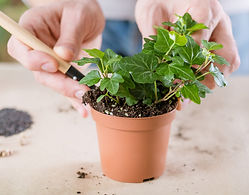People Are Asking.
How Best To Grow Plants In Pots and Containers.
TEN TIPS

1. Select Your Container

Every container says something about you and the image you are trying to create. You can grow plants in an Old Boot, or anything that will hold “soil”, and has adequate drainage. Planting containers can be traditional clay pots, plastic pots, wine barrels, or planter boxes. As you will see, each has its advantages, and disadvantages.
2. Select Correct Locations

The best thing about containers, they can be put almost any place you want them, so long as they get their required sunlight or shade. The sunny Marigold will do best in 6+hours of direct sunlight. The tenders Impatient will thrive in total, daylong shade.
3. Select The Right Plant

With sunlight availability addressed, you have hundreds of foliage and flowering plants that can be grown successfully in containers. Most will require the necessary 6+ hours of sunlight per day. A very few, like the colorful Impatent will demand a shady location to realize blooms. Two of the most popular sun lovers are Geraniums ( perennial ) and Petunia ( annual ). Note: Wave® Petunias are noted for their ability to blanket a bed, or container. Supertunia® varieties are suited to hanging baskets as their flowering stems can hang down for as much as 3 feet.
4. Thrill. Fill. And, Spill.

Certainly a pot crowed with blooms of the same plant can be breathtaking.
But, a container planted with a tall slender planin the center ( the Thrill ) surrounded by a mass of low, blooming plants ( the Fill ), and flowering or foliage plants, that cascade over the edge ( the Spill ), can be a planting to
catch the interest and admiration of all who view this delight.
5. Soil Makes A Difference

You will recall from my “How Plants Grow” guide, soil is the foundation for successful container planting. There are dozens of “bagged soils” available.
Try to narrow them down to just two categories. Those labeled “potting soil” and those labeled “succulent soils”. The secret to both is their ability to allow moisture, and equally important, air (vapor) to move in the soil.
My recommendations are listed below.
6. Watering Containers Is Key

Two things are key to successful watering in a container. Good drainage leaves the root zone just moist and still room for air to circulate. ALL containers must drain completely between waterings. Raised beds have lots of drainage. But, take care to ensure pots ( and other modified containers) come with at least one drain hole. Or, permits you to make one or more holes with a drill and bit. When drilling my own, say in a oak barrel, I like 4 or 5, one inch holes.
7. Elevate A Few Inches


Placing some ridge form (chunks of brick, wood blocks, etc.) under pots is a good practice. This margin of an inch or two will permit the full drainage after each watering and let air freely enter the drainage holes. “Lifted pots” have one other advantage. The air gap insulates pots that must be placed on hot concrete surfaces, greatly reducing the direct radiation of intense heat up into the pot. Unchecked, this extra heating will hasten the drying out of the pot and the need for more frequent watering.
8. Construction Counts
The classic terra-cotta clay flower pot has many virtues. It’s one vice is permitting moisture to evaporate through the pours of the clay. Freely giving up valuable moisture is especially prevalent in clay pots set out in the hot, late afternoon sun.
Alternatives include thick expanded foam pots, molded PVC forms, or treating the inside with a coating of any latex paint. This is especially recommended if you desire the "aging of the clay on the outside. To preserve the fresh clay look and prevent evaporation, spray the outside with a clear, flat varnish. Or, if you are looking to give your posts expression, paint the outside with your favorite color of latex paint. Learn more about the versatile line of Mayne PVC planters below.
9. Challenging Shapes

Pots, combined with plants, each have a future. But the future of either can be threatened by the shape of the pot. A pot with straight, or inwardly sloping sides each have a future, especially at transplant time. But, that cute spice jar pot has shoulders wider than the top opening. So, when it’s time to re-pot the plant, the shoulder area is densely packed with roots. So, you must choose. Do you damage the plants roots to get the plant past the opening? Or, do you break the pot to prevent damaging the plant you’ve nurtured for so long??
10. Make Moving Easy

You might have found the perfect location for your favorite flowering plant. But, then you put up your patio umbrella and this sun bloomer is shaded for a good part of the day. Now, you loose most or all the blooms. Raised bed gardens set up in early spring, could be shaded all summer, when the neighboring tree(s) leaf out in late spring. These considerable investments might have to be moved next season to enjoy a enough sunlight to realize a bountiful harvest.
UV Resistant Self-Watering Planters From Home Depot




